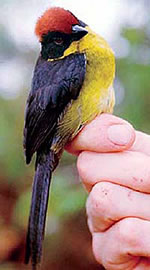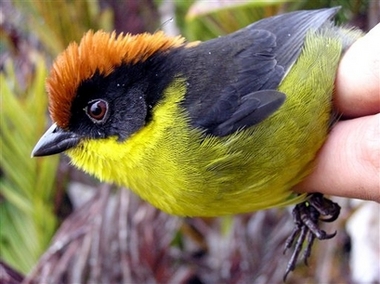The newly described YariguÃes Brush-Finch,
Atlapetes latinuchus yariguierum.
Photo: Blanca Huertas, Natural History Museum.
A previously unknown subspecies of bird was discovered on an isolated South American mountain range. This coloful bird is approximately the size of a stick of butter. It has a fiery rust-red cap, lemon-yellow throat and a sooty-yellow belly streaked with bright yellow that contrast with a black beak, eye patch, wings, legs and tail (pictured). The bird's coloration distinguishes it from its closest relative, the Yellow-breasted Brush-Finch, because its back is black and it lacks a white bar on its wings.
Two birds were captured in January 2004, both of which were photographed and their DNA sampled. The research team released one bird unharmed, but the other bird died shortly after capture so its body was prepared for scientific study. Its body is now located in the museum collection at the Instituto de Ciencias Naturales, Universidad Nacional de Colombia.

This is the first time that a live specimen has been used as the basis for a formal scientific description of a new bird subspecies.
"There are about two to three new birds found in the world every year," said Thomas Donegan. "It's a very rare event." Donegan is from the Colombian bird conservation organization, Fundacion ProAves.
"The description of a new bird is a rare event in modern times," agreed co-discoverer Blanca Huertas. Huertas is a lepidopterist and curator at the Natural History Museum in London.
The bird was named the YariguÃes brush-finch, Atlapetes latinuchus yariguierum, in honor of the indigenous people that formerly lived in the mountainous area where it was found. According to legend, the YariguÃes tribe committed mass suicide to avoid enslavement by the Spanish conquistadors.
This subspecies is a new member of the Atlapetes latinuchus species complex. A species complex is a group of closely related species, or "taxa" as they are known by scientists, that are difficult to distinguish. The description was published in the June 2006 issue of the scientific journal, Bulletin of the British Ornithologists Club.
To access the bird's isolated habitat, Donegan and Huertas were dropped by helicopter onto an isolated peak in the SerranÃa de los YariguÃes mountains in northern Colombia at 10,000 feet above sea level. This is the first time that scientists have visited the highest elevations in this mountain range. This bird is also found in other nearby mountains in Colombia's Eastern Andean range.
"This is just the first of several new species that we will be describing from the YariguÃes mountains," promised Huertas. "In my own specialist group, butterflies, we have found several new taxa that will be described soon," Huertas added.
"Before we began this study, no one knew what species lived in the YariguÃes mountains and whether they needed protecting," said Donegan.
This discovery is important because this subspecies lives in a 500 acre tract of pristine cloud forest that the Colombian government recently set aside for a new national park, the Cerulean Warbler Bird Reserve.
Sources:
Blanca Huertas (Images)
Bulletin of the British Ornithologists' Club (formal scientific description: PDF)
Natural History Museum (Story, quotes)
ProAves (Story, quotes)
Reuters (Story)
.


Thank you for this wonderful article, and congratulations on your transition back to longer and more in-depth articles.
Grrl, there's no actual molecular data used in the diagnosis of this species in that PDF. Basically it's based on morphometric and plumage data.
Yes, i understand that the paper is a morphological description only, that the bird's DNA has not yet been published. however, they do HAVE its DNA and have probably sequenced several genes from it by now (two and a half years after the discovery) -- i'm guessing they sequenced the bird's mitochondrial DNA or maybe a nuclear intron or two. the hold-up in describing this bird formally using DNA data is probably due to the fact that DNA data is valid only in context, meaning that they need DNA sequence data from the same genetic material in all (or many) of its close relatives, too.
That is a damn cute bird, in any case.
She baaack! Yay!
Nice work, G/S. I love the photo. I also await your fully-fledged (heh) return to your public out here. I alos have a jones for regular postings of Birds in the News after this long interval. Go you owl!
Well, it's "only" a subspecies but good news nonetheless. It's a nice touch that they tried to avoid sacrificing the birds.
I can't tell you how happy I felt when I saw that you were again posting on birds! But don't feel pressured, it's important that you make a full recovery.